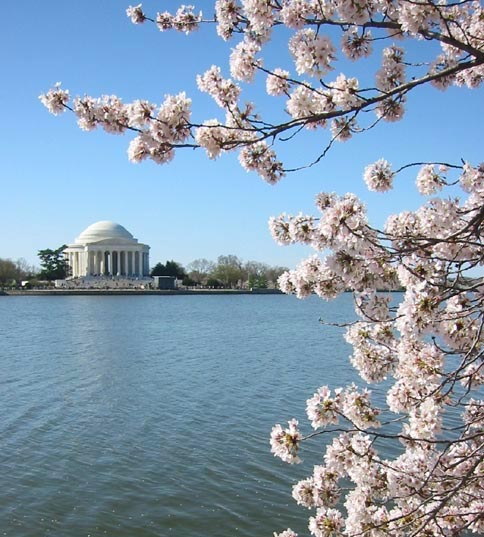How to Predict Cherry Blossom’s Full Bloom
By Ann M. Mason, Fairfax Master Gardener
 It’s March and our Metro DC weather is turning warmer. In our Washington, DC Metro Area, the sentinel event of late March and April is the blooming of our cherry blossoms. For a short 5- to 14-day period we marvel at the beauty of spring. In Japan, cherry trees are revered. For centuries every spring, the Japanese have celebrated festivals, called ‘hanami,’ flower viewing, a time to admire and celebrate the blossoms. Cherry blossoms symbolize the cycle of life, death and rebirth.
It’s March and our Metro DC weather is turning warmer. In our Washington, DC Metro Area, the sentinel event of late March and April is the blooming of our cherry blossoms. For a short 5- to 14-day period we marvel at the beauty of spring. In Japan, cherry trees are revered. For centuries every spring, the Japanese have celebrated festivals, called ‘hanami,’ flower viewing, a time to admire and celebrate the blossoms. Cherry blossoms symbolize the cycle of life, death and rebirth.
Our first cherry blossom festival was held in 1927. In 1912, the Mayor of Tokyo, Japan gifted over 3,000 cherry trees, including 12 varieties, to the United States. After some discussion and the intervention of Mrs. Taft, the first lady, these cherry trees were planted around the Tidal Basin. To return the good will gesture, the U.S. gifted flowering dogwood trees to Japan.
Each year we hear or read newscasters from various organizations make predictions for the peak blooming time of the Washington Tidal Basin’s Yoshino Japanese flowering cherry trees (Prunus x yedoensis), a member of the rose (Rosaceae) family.

Six Stages of Cherry Blossoms
How do they make these predictions?
Weather temperatures in December through March play a role in when green buds will emerge. Horticultural experts report that the Yoshino cherry and other cultivars like the ‘Kwanzan,’ ‘Ichiyo,‘Akebona,’ ‘Perpendens’ and ‘Shidare’ display similar stages from bud to full bloom. But not all these cultivars start the green bud formation at the same time as the ‘Yoshino.’
Let’s examine the plant’s response to weather. What signals from the tree should we look for? Horticulturists report that there are five or six stages for the acute gardening observer.
Stage 1: Green bud formation. This stage can last a long time. So, what we know when we see green buds is that the blooming process has started.
Stage 2: Emergence of florets. Once one sees the flash of pink emerging from the bud, the predicted time for full bloom is within 20 days. Weather temperatures will influence how much earlier the blossom will fully emerge. Warmer temperatures can shift blooming forward to as short as 12 days. Keep watching for other signals.
Stage 3: Extension of florets. The rounded bud shape extends into the typical tubular-shaped floret in a composite flower head.
Stage 4: Peduncle elongation. Peduncle, the stalk bearing the flower, lengthens.
Stage 5: First appearance of fluffy white petals. Petals will start to unfurl and emerge. Now one can expect the flowers to fully emerge within 4 to 6 days.
Stage 6: Full bloom. Enjoy the show of lovely pink to white blossoms on the tree’s graceful branches. Warm temperatures (above 60 degrees F) will shorten full bloom appearance to 4 to 5 days; temperatures cooler than 60 degrees F will extend the bloom to last up to 10 days.
Sadly, the National Park Service urges people to observe trees locally. With the continued Covid-19 safety restrictions the National Park Service does not want visitors to the National Mall and Tidal Basin in 2021.
Instead, enjoy monitoring your favorite cherry tree in your yard or neighborhood. This is a great time to track the stages of blooming in your garden journal and encourage your favorite young gardeners to start their 2021 gardening journal.
Resources
• Six stages of cherry blossom development from buds to flowers, Jessica Tremblay,
Vancouver Cherry Blossom Festival
• Cherry blossom boom, Live Science